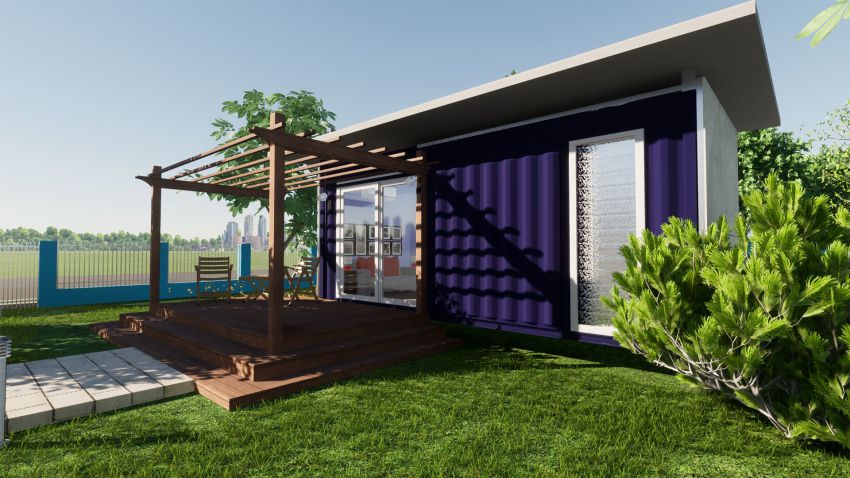- Rent, Lease, or Purchase
- |
May 7, 2018
Shipping Container Apartments

Converting shipping containers into apartment buildings is fast becoming a trend, with hundreds of incredibly aesthetic and functional shipping container apartments popping up around the world.
From single container home units to affordable housing complexes, designers and architects can utilize container architecture to build a wide range of housing complexes.
What is a Shipping Container Apartment?
As the name suggests, container apartments are homes made from steel shipping containers. Though the concept is simple, the preparations involved in this kind of construction are slightly more complex.
A container apartment can range from a 100 square feet home to multi-storied units. Some apartments consist of pre-built, modular units, while others have a fully custom-built design.
Besides their aesthetic qualities, container homes offer a highly cost-effective alternative to prefabricated and modular homes. If you're looking for a place with lower construction and maintenance costs, a shipping container apartment may be the right solution for you.
Some may prefer shipping containers for temporary projects, or if they have plans to move and want to take their home with them.
With about 11 million “out-of-service” containers lying unused, building container apartment complexes is also an innovative way to go green.
Home vs. Apartment

The most common shipping container sizes are 10 ft., 20 ft., and 40 ft. A 20-foot shipping container home can provide approximately 160 sq. ft. of living space; most ideal for a single person.
An apartment complex is a larger unit that uses multiple containers in its construction. For example, to create a two-story building, you may require about eight large containers. That kind of apartment will provide about 1400 sq. ft space.
There are also micro-apartments that exist within larger apartment buildings, made of hundreds of containers stacked together. While container apartments are generally 2-3 floors at most, some stand upwards of 7 stories high.
Traditional Homes vs. Container Apartments
While both types of buildings come with both pros and cons, a side-by-side comparison helps highlights the benefits of container apartments over traditional homes:
Cost of Construction
Container homes may seem costly due to design complexities, additional steel reinforcements, or exterior modifications. However, container conversions require lesser labor and building materials.
Some estimates predict that building a container home can help you save about 15-50% the cost of a traditional house.
Additionally, estimating the budget for a conventional apartment can be tricky, as it’s hard to account for various uncertainties. Comparatively, containers are largely factory-fitted. The only variability comes in the form of delivery price, site preparation, accessories, and utilities.
Quicker Turnaround Time
A traditional brick-and-mortar building can take anywhere between two to six months to construct. In comparison, many shipping container homes have a prefabricated modular structure that significantly reduces the construction time.
Most companies conduct building code inspections at the factory site itself, allowing them to deliver container apartments in less than a month.
Portability and Ease of Transport
While shorter construction time and predictable pricing are advantages often associated with modular buildings, shipping container homes offer additional portability benefits that make it much easier to take your home wherever you go.
The versatile design of shipping containers is also highly beneficial in building emergency shelters during a disaster.
Architectural Differences
Shipping containers do boast certain design limitations that can cause delays for your project. Drilling doors and window holes can cause moisture build-up, and will require regular maintenance to retain the container's structural integrity. A traditional house is more open to design and aesthetic possibilities due to lesser limitations and considerations.
Environmental Impact
Using old shipping containers as apartment units is an effective way of recycling. Container designs that need minimal modifications are a great way to avoid waste and excessive usage of natural resources.
That said, converting containers into habitable spaces may also require sandblasting, flooring replacements, torch-cutting, and so on. Major interior finishes and other modifications in any structure are bound to increase waste and debris.
Still, building container homes by recycling old, used shipping containers remains more environmentally conscious and more eco-friendly than a traditional home.
Cost of Living in Container Apartments
A decommissioned container can cost anywhere between $1,800 to $5,000. Delivery, assembly, site preparation cost around the same.
Generally speaking, a basic container home will anywhere range between $10,000 to $35,000. Several factors, including the size and number of containers, welding and fabrication, plumbing and electrical utilities, flooring, kitchen appliances, bedroom furniture, and interior modifications, can increase costs.
You can also purchase large homes built with multiple shipping containers and amenities that may fall in the $100,000-$175,000 price range.
Renting a container home in a housing community can help you save upfront costs. For instance, rents for a 320 sq. ft. apartment in this Jacksonville complex start at about $700 a month. Similarly, a 740 sq. ft. apartment with amenities in Downtown Phoenix will cost you about $1,000 a month.
Our renter's guide can help you select the best shipping containers for your apartment.
Living Space Available in Shipping Container Apartments
A typical 10-foot container has the following dimensions:
- Exterior: 10' 0" Length x 8' 0" Width x 8' 6" Height
- Interior: 9' 4" Length x 7' 8" Width x 7' 10" Height
Both 20-foot and 40-foot shipping containers have the same width and height, with the only difference being their length. You can get around 320 sq. ft of carpet space or about 2,390 ft3 storage in a 40-foot container.
You can also contact an expert builder to create an efficient floor plan to maximize the available space. With due consideration for storage, partitions, bedroom furniture, shelves, and furnishings—or by stacking several units, you can obtain more space in the available ground area.
Learn more about shipping container dimensions.
Examples of Container Apartments
The following homes and apartments rely on the versatility of containers to create efficient solutions. From solving housing shortage problems in crowded cities to building artful housing complexes, these apartments are goals:
Containers on Grand, United States

This housing complex in Arizona features eight units made from 16, 40-foot shipping containers. The units were so popular before being launched; there was a 200-person waitlist.
The Oscar, United States

The Oscar is a large apartment complex that consists of thirteen units, including two design studios.
The Sea Container Housing, United States

The owner chose to demolish the existing structure and build aesthetic student housing instead. The entire process took just six months. Renting a place in this Washington D.C apartment can cost you as much as $6,500 a month.
Potter's Lane, United States

Potter's Lane is another container marvel that engineers built within just six months. Used as a veterans housing commune, this place now features a beautiful courtyard as well.
La Aduana, Mexico

This eight-story container apartment in Mexico uses 36 containers on a 2,300 sq. ft of land to create eight highly functional units.
Keetwonen, Netherlands

Built in just nine months in attempts to tackle the housing shortage, this 1000-unit apartment complex became the world's largest student container home campus. However, since the city underwent redevelopment, the council disassembled the building and is now reselling these container homes.
Cité A Docks, France

With its large windows and light color scheme, this 100-unit apartment creates an immense sense of space and is one of the most creative examples of shipping container homes.
Conclusion
Shipping containers offer a versatile and flexible architecture for building aesthetic apartment buildings. There are endless possibilities to how you can create an artistic, functional, and robust shipping container apartment of your own.
Want to know more about shipping container homes and their cost? Contact us at 866-459-7600 or request a quote today.
Frequently Asked Questions
Which states allow shipping container homes?
Texas, California, Tennessee, Missouri, Oregon, Louisiana, and Alaska are some of the states that allow container homes. With shipping container buildings growing in popularity, more states will likely allow them without any hassles.
How much does it cost to live in a shipping container?
You might spend anywhere between $10,000 to $35,000 to build a shipping container home. A luxurious container apartment with high-end amenities can fall in the $100,000 to $175,000 price range. Renting a container apartment can be more affordable, with prices starting at $700 a month.
Do container homes rust?
Shipping containers have a Corten steel body that may rust due to moisture in the environment. Painting your container home or doing special exterior modifications can help prevent rusting.
Learn more about our in-house team of technicians and mechanics that will provide you with top-notch office container maintenance services.
Related Blogs



Subscribe to Our Blog
Enter your email address to subscribe to the blog and receive the notification of new posts by email.
Thank You for Subscribing to Our Blog!
Stay tuned for upcoming emails with valuable content that we hope will enhance your experience with our brand.
Both Pardot and mg360 form submissions failed.
